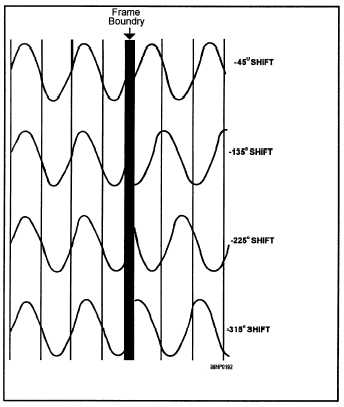interrogation message or at the end of an NCS report
and interrogation message. When the DTS recognizes
its own station address, it starts to transmit the
preamble. During the first frame of the preamble, the
DTS sets the prepare-to-transmit interrupt on the
input data lines. The computer samples the interrupt
and sends an IDA to acknowledge receipt of the
interrupt.
The DTS finishes sending the preamble and phase
reference frames.
During the second frame of the
start code, the DTS sets the output data request (ODR)
active, requesting the first word of the tactical data.
The CDS ‘computer responds by placing 24 bits of
data on the lines and then setting the output data
acknowledge (ODA). The DTS samples the data and
clears the ODR. The first frame of data is processed
for transmission and the ODR line is then set to
request the next data word.
This procedure is repeated until all the data words
have been transmitted. Once the CDS computer has
completed sending all the data words, it will not
acknowledge the ODR from the DTS. If the CDS
computer has not acknowledged an ODR from the
DTS in a preset amount of time, the DTS will clear
the ODR line and generate a stop code. Upon
transmission of the two-frame stop code, the DTS will
return to the receive mode.
Net Control Station (NCS) I/O Operations
The station acting as NCS follows the same
protocols when communicating with the CDS
computer. Some differences exist in the generation of
the control codes.
The net control station is
responsible for interrogating each station. Upon
receipt of a picket stop code, the DTS checks the next
station address and sends an interrogation message.
After the interrogation message is transmitted, the
DTS waits to receive a start code from the
interrogated station. If a start code is not recognized
after 15 frame intervals, the station will be
reinterrogated. If a start code is not received after
another 15 frame intervals, the address control unit
will advance to the next active picket address and
repeat the interrogation process.
The other major difference is when the net control
station has completed its own tactical data
transmission, a control stop code, followed by the
next station address, is transmitted. Again, if a start
code is not received within 15 frame intervals, a
second interrogation is sent.
This second
interrogation is a normal interrogation message
consisting of the preamble, phase reference frame, and
address code.
Modulator/Demodulator
The modulator/demodulator function of the DTS
provides the digital to analog and analog to digital
conversion.
During data transmission, the 24-bit
binary data word is expanded to 30 bits by adding the
six bits for error detection and correction. The 30 bits
are then examined in pairs to determine the required
phase angle shift for each of the 15 data-carrying
tones in the audio package.
Figure 2-19.—Link-11 frame boundary phase shifts.
At the frame boundary, the phase of each data
tone is shifted with respect to the previous frame.
2-18

